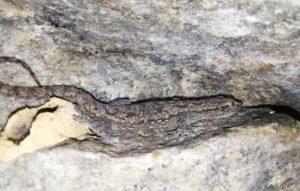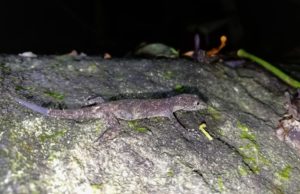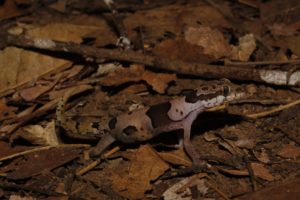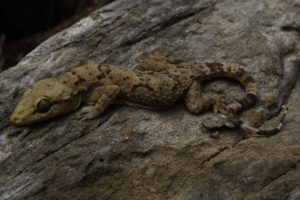
Lizards first appeared on Earth more than 260 million years ago, and today there are almost 4000+ different known species, making them the largest group of reptiles. They come in a great variety of shapes and sizes, from giant Komodo dragons and tiny geckos to colour-changing chameleons and slow-worms with no legs at all. And also lizards live almost everywhere from rocky mountains and Arctic tundra to arid desert and the Rain forest canopy.
The geckos are one of the main groups of reptiles. They belong to the group Scleroglossa known as hard-tongued lizards. Their tongues are hard and flat. There are 2700+ separated species of hard-tongue lizards including geckos, skinks, monitor lizards, lacertid lizards and zonures. Geckos are cold-blooded animals. Their internal organs are similar to those of most land-living vertebrates, but the heart has only 3 chambers, unlike others. Two chambers called the atria, receive blood from the body. Oxygen-rich blood from the left atrium is kept separate from oxygen-poor blood the right. Geckos have special breath-holding abilities, extrasensory organs and telescopic (extendable) tongues. They shed their outer skin layer like other reptiles in order to grow. But unlike snakes, they shed the dead skin in pieces. All of the geckos have the ability to lose their tails for protection. Some species have brightly coloured tails that, combined with a tail-waving motion, attract a predator’s attention and draw its attack away from the gecko’s head and body. The muscles at the severance point collapse to seal the end of the tail and prevent blood loss. The wound soon heals and the lizard grows a new tail. Most of them are nocturnal and insectivores. But, there are much larger geckos such as Tokay gecko that eats other lizards as well. Geckos can be either nocturnal or diurnal. Those geckos that being active in the day-time call Day-geckos.
They are widely distributed all over the world. Geckos belong to Family Gekkonidae and there are 61 genera in the world and Sri Lanka is home for 7 genera. They are Cyrtodactylus, Cnemaspis, Hemidactylus, Gehyra, Calodactylodes, Hemiphyllodactylus and Lepidodactylus. Gehyra, Lepidodactylus and Calodactylodes genera have only one species for each in Sri Lanka. And also all the species that belong to Genus Cnemaspis are endemic to Sri Lanka. And Sri Lanka has 61 species of geckos at present.

In Sri Lanka, there is a very rich diversity of geckos all over the country including the dry zone, wet zone, intermediate zone and even in the mid-hills. All of them are nearly insectivores. Hemidactylus hunae is the largest known gecko of Sri Lanka and Cnemaspis retigalensis is the smallest one.
Genus Calodactylodes
They are commonly called Golden geckos. Distributed in India and Sri Lanka. Sri Lanka has only one species that belongs to this Genus called Calodactylodes illingworthorum. Their ventral side is gold in colour and that is the reason to call them as Golden-geckos. C.illingworthorum is distributed in the dry zone. They usually live in rocky caves and lay eggs in drip moulds. Eggs can be seen as clusters with hundreds of them.

Genus Cnemaspis

Commonly known as Day-geckos. Sri Lanka is the home for 37 species of the Genus Cnemaspis. Distributed through-out Sri Lanka including wet-zone, dry zone and the intermediate zone. The smallest gecko of Sri Lanka (Cnemaspis retigalensis) belongs to this genus. And also all of the geckos that belong to this genus are endemic to Sri Lanka. Commonly found in shaded areas like rocks, fallen tree logs and moss-covered substrates.
-
-
-
- Cnemaspis alwisi
- Cnemaspis amith
- Cnemaspis anslemi
- Cnemaspis butewai
- Cnemaspis dissanayakai
- Cnemaspis gemunu
- Cnemaspis godagedarai
- Cnemaspis gotaimbarai
- Cnemaspis hitihami
- Cnemaspis ingerorum
- Cnemaspis kallima
- Cnemaspis kandambyi
- Cnemaspis kandiana
- Cnemaspis kawminiae
- Cnemaspis kivulegedara
- Cnemaspis kohukumburai
- Cnemaspis kotagamai
- Cnemaspis kumarasinghei
- Cnemaspis latha
- Cnemaspis manoae
- Cnemaspis menikay
- Cnemaspis molligodai
- Cnemaspis nandimithrai
- Cnemaspis nilgala
- Cnemaspis pava
- Cnemaspis phillipsi
- Cnemaspis podihuna
- Cnemaspis pulchra
- Cnemaspis punctata
- Cnemaspis rajakarunai
- Cnemaspis rammalensis
- Cnemaspis retigalensis
- Cnemaspis samanalensis
- Cnemaspis scalpensis
- Cnemaspis silvula
- Cnemaspis tropidogaster
- Cnemaspis upendrai
-
-
Genus Cyrtodactylus

Genus Cyrtodactylus is the largest gecko genera in the world. Commonly known as Bent-toed Geckos or Bow-fingered Geckos. It has at nearly 250+ described species at present. Distributed only in Asia. In Sri Lanka, there are 9 species.
-
-
-
- Cyrtodactylus cracens
- Cyrtodactylus edwardtaylori
- Cyrtodactylus fraenatus
- Cyrtodactylus ramboda
- Cyrtodactylus soba
- Cyrtodactylus subsolanus
- Cyrtodactylus triedrus
- Cyrtodactylus yakhuna
- Cyrtodactylus collegalensis
-
-
Genus Lepidodactylus
Lepidodactylus is a genus that nearly related to the Genus Hemidactylus and Gehyra. Commonly known as Scaly-toed geckos. There is only one species in Sri Lanka. Lepidodactylus lugubris (Mourning Gecko). They are distributed all over the world. They can be found even in human habitats too.
Genus Hemidactylus

It is the second-largest gecko genus in the world. There are more than 160 described species at present. Commonly known as House Geckos. The most common gecko genus and commonly found in forests and disturbed man-made habitats. Sri Lanka is the home for 11 species. Hemidactylus hunae is the largest known gecko in Sri Lanka.
-
-
-
- Hemidactylus brookii
- Hemidactylus depressus
- Hemidactylus frenatus
- Hemidactylus hunae
- Hemidactylus lankae
- Hemidactylus leschenaultia
- Hemidactylus parvimaculatus
- Hemidactylus pieresii
- Hemidactylus platyurus
- Hemidactylus scabriceps
- Hemidactylus triedrus
-
-
Genus Gehyra
Commonly known as Web-toed geckos (Dtellas). They are closely related to the genus Hemidactylus. Commonly found in disturbed human habitats. There is only one species in Sri Lanka. Gehyra mutilata (Stump-toed Gecko). Distributed all over Sri Lanka.
Genus Hemiphyllodactylus
Usually known as Half Leaf-fingered geckos. Sri Lanka is the home for only one species of Genus Hemiphyllodactylus (Hemiphyllodactylus typus). Distriuted in Sri Lanka, India, China, Southeast Asia and Oceania.
Geckos act a main role in the ecosystem. They are good pest controllers because their main diet is the insects. Geckos can be found in nearly all types of habitats including dry zone forests, wet zone forests, mid-hills, crop-lands and even in highly disturbed human habitats. There are some myths that linked with geckos in Sri Lanka like “Hearing their calls and falling onto the body are taking unlucky to the person”. They don’t have any scientific backgrounds. But, some geckos can be poisonous when eaten. And also they spread bacteria such as Salmonella sp. But those geckos are very important to the environment and maintain the balance of the ecosystem.
Special thanks to Angelo Hettige for sharing his knowledge and supporting through the article series.
Reference:
3.new.geckos.Cnemaspis.Sameera.Karunaratne.dissanayakei Cnemaspis_gemunu (Sri Lanka) Five_New_Cyrtodactylus (Sri Lanka) Cnemaspis_anslemiSriLankaCHECK THIS OUT: INTRODUCTION FOR DRAGON LIZARDS

